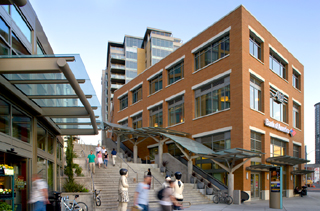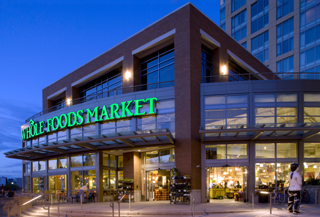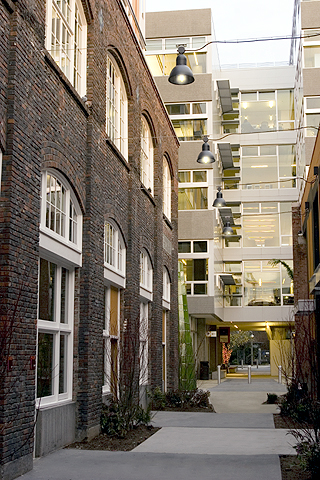
Surveys
DJC.COM
December 7, 2007
Retail evolves in mixed-use projects
Vulcan Inc.

Healey
|
Shifting demographics and evolving customer preferences are transforming the urban retail landscape. Today’s fastest-growing households — including young professionals, empty nesters, single parents, senior citizens and couples without children — often have very different shopping expectations than households of earlier generations.
Customer experiences must be tailored to fit the needs of both the community and project site, as well as the competitive demands of the market. As the city becomes denser, exciting and innovative shopping environments are being created that reflect new urban retail formats, shared public spaces, tenant mixes, parking configurations and access to transit links.
Successful retail hubs in redeveloping urban neighborhoods are being designed to support the daily needs and lifestyle preferences of a 24-7 customer base. They have a mix of complementary uses, reflect an authentic variety of homegrown and national retailers, deliver a sense of place, and are pedestrian-friendly or located close to public transit.
Mixed-use appeal

Photos courtesy of Vulcan Inc. At 2200, wide sidewalks and landscaping help give the development a sense of place. |
Whether it’s the mix of retail tenants or the mix of retail, residential and office uses, incorporating retail in an urban environment should be planned comprehensively as an integral piece of the larger community.
Proximity to essential goods and services is a key factor that people consider when choosing a place to live. Residential units and offices above retail keep the street active around the clock, providing convenience for residents and employees while supporting greater sales volume for retailers.
At the 2200 project located at the gateway to South Lake Union — which includes condominiums, a hotel and retail shops and restaurants — incorporating a desirable grocery store as a retail anchor was essential to the vitality of the larger neighborhood as an appealing place to live.
As the first major urban grocery in downtown Seattle in nearly a century, Whole Foods Market not only fills a major void for a premier urban grocery store serving the area’s growing base of employees and residents, but also attracts a wider customer base that benefits the project’s other retailers.
Retail at the Alley24 mixed-use project in South Lake Union’s Cascade neighborhood is geared toward a varied customer base visiting throughout the day, including more than 1,200 daytime workers and residents within the project, nearby employers, residents in the neighborhood and shoppers from surrounding communities.
Particularly in an emerging neighborhood, restaurants that serve both daytime and evening crowds are one of the most sought-after amenities. Accordingly, the retail space at Alley24 was carefully designed to accommodate the unique space and design needs of several street-level restaurants, a café and deli to provide new dining options in a fast-developing area.
Alley24 also has complementary retail uses that leverage its proximity to retail anchor REI and draw from an existing and loyal customer base. Located directly across the street from REI’s flagship store, Alley24’s retailers, including Snowboard Connection and GolfTEC, help reinforce the area’s reputation as an outdoor recreational shopping destination and maximize the market appeal of the project’s other retail offerings.
Community and authenticity

Whole Foods anchors the retail at 2200. It is the first major urban grocery store in downtown Seattle in nearly a century. |
While retail centers have historically been isolated, enclosed single-use developments, shoppers are now seeking authenticity and a deeper sense of community. Increasingly, many shoppers now prefer outdoor retail environments characterized by lively streetscapes that are better integrated with other daily activities.
Projects with inviting public gathering spots, wide sidewalks that can accommodate outdoor seating, and picturesque landscaping help create a sense of place that turn basic errands into memorable experiences.
The five-sided site and 35-foot sloping topography characterizing 2200 created unique opportunities for the project to better integrate into the community. Above Whole Foods, an expansive outdoor retail plaza at the heart of the project can be accessed by a grand central staircase, escalator or side streets. Entrances to 2200’s restaurants, shops, Pan Pacific hotel and condominiums front the open retail courtyard, which also has outdoor seating, benches and open space.
This type of retail orientation allows visitors to feel more comfortable as they move about within the development, and as they move between the development and surrounding community.
Projects that mix local homegrown retailers and larger national retailers also help deliver a more authentic shopping experience that can’t be duplicated. At Alley24, local businesses such as Urban Beast, Spa Blix, Espresso Vivace, tottini, Mad Pizza, Southlake Grill, Velocity Art & Design, and Snowboard Connection distinguish the neighborhood from the downtown retail district’s existing establishments and add new layers to the area’s eclectic personality.
Transit links

Alley24’s retail mix is targeted to its residents and daytime workers, as well as residents and workers from nearby buildings. |
As traffic congestion continues to increase in our region and people crave more convenience in their daily lives, retail destinations that are walkable and easily accessible by public transit will be best positioned for sustained success. As such, retail stores and services located within walking distance or near public transit offer a competitive advantage in attracting a wider and more consistent customer base.
The upcoming Seattle streetcar that begins operating in mid-December helps support the retail vitality of South Lake Union and greater downtown area by linking a growing number of workers, residents and visitors to businesses located along the streetcar line. For the first time, shoppers in the downtown retail core can hop on a streetcar at the Westlake Center hub and connect to nearby South Lake Union retailers, or vice versa.
The parking factor
With limited parking in urban neighborhoods, creative approaches to retail parking are being used that also take into account proximity to public transportation, short-term parking spaces on city streets, as well as residents and workers located within walking distance of the project.
Increasingly, paid and validated parking systems are being introduced as the new paradigm for urban retail locations. The amount of parking needed for mixed-use projects with retail can also be reduced and shared since peak demand times vary among the different uses. For example, a single parking garage serves multiple users at Alley24 throughout the day and is shared by the project’s residents, employees and retail visitors.
South Lake Union represents a microcosm of the evolving 21st century retail landscape — introducing new retail uses that spur greater economic vitality, provide convenience in daily lives, deliver an authentic shopping experience and foster a stronger sense of community.
Incorporating new retail uses into a mixed-use urban project is a complex undertaking, particularly within a fast-growing neighborhood that previously offered limited shopping and dining opportunities. However, if it is approached with a holistic vision and keen understanding of the community’s evolving needs, the result can be a vibrant, authentic retail experience that enlivens a neighborhood’s character and livability.
Ada M. Healey is vice president of real estate for Vulcan Inc., which manages a diverse development portfolio that includes approximately 60 acres in Seattle’s South Lake Union neighborhood.
Other Stories:
- Commercial real estate continues its strength
- Use cost segregation to cut Uncle Sam’s bite
- Too many condos in Seattle? Think again
- An urban village emerges on Seattle’s First Hill
- Pros and cons of the Industrial Jobs Initiative
- What’s next for Seattle’s CBD office market?
- Developing retail? Here are some things to know
- Downtown becomes too pricey for disabled homeless
- Workforce housing shortage is a ‘silent epidemic’
- Now is the time for apartments — but beware!
- Will good times continue for our market?
- Full speed ahead as CBA turns 30
- CBA Insights speaker profile: Dennis Wilde
- CBA Insights speaker profile: John Parker
- CBA Insights speaker profile: Linda Berman
- Hot Eastside office market won’t get red hot
Copyright ©2009 Seattle Daily Journal and DJC.COM.
Comments? Questions? Contact us.